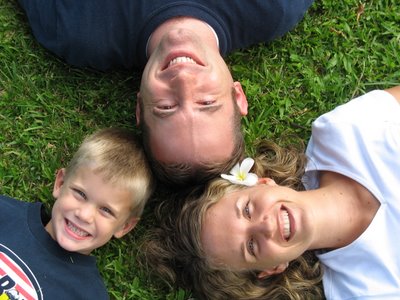So, What Did the Tourists on Queen Mary Think of AS?
I enjoyed this article in The Australian about one woman's experience upon landing in Pago Pago harbor last month on the Queen Mary II. It makes me happy to hear that American Samoa can still give its visitors that island charm.

Show of flower power bowls a maiden over
DEPARTURE LOUNGE Susan Kurosawa
March 17, 2007
DEPARTURE LOUNGE Susan Kurosawa
March 17, 2007
THE term maiden world voyage sounds deliciously antiquated, as if one would expect said ship to be full of tea-sipping Miss Marple look-alikes in cardigans and brogues. This definitely has not been the case as Queen Mary 2 makes its inaugural loop from Fort Lauderdale via the Pacific and Asia to Southampton, causing a stir of Hollywood star proportions wherever it arrives.
San Francisco and Sydney hold the honours thus far for harbour spectacles: spectator craft galore (looking as small as bathtub toys) bobbing around the QM2, media fanfare and fireworks, fireboats with their water-spray welcomes, traffic snarls and public transport stoppages.
These maiden voyage performances have been well chronicled but less heralded was QM2's arrival at Pago Pago on the island of Tutuila, American Samoa, on February 13. Our arrival into port was slow and purposeful, along a deep dredged channel, rimmed with reefs and sandbars.
Dressed-to-the-nines dignitaries, including a resplendent Miss American Samoa, were on the docks as the ship pulled in. QM2 cast a 62m shadow over an assortment of container sheds and port offices, looming so large that the low-rise tuna-cannery town seemed of Legoland proportions.
In a neat avenue between the gangway and the port entrance, stalls had been set up, selling the expected South Seas inventories of baskets, shells, sarongs and vivid shirts.
But also on display were fantastic arrangements of flowers -- heliconia and strelitzia, spiral ginger and branches of sweet frangipani -- decked with red ribbons, hearts and Valentine's Day greetings. The enterprise of the local women was well rewarded: the American passengers, in particular, bought so many of the big bouquets that the stallholders' young children were sent racing off to find more flowers. I had a vision that night of all the gardens in Pago Pago denuded of their bright bounty as a thousand cabins across the QM2 gleamed with flourishes of red and gold.
I can't imagine too many passengers feeling thrilled at the prospect of Pago Pago on the itinerary. It isn't one of the big-hitters -- everyone on QM2's maiden world voyage was poised to get to Sydney -- but sometimes it is the small, contained ports that offer the unexpected, and therefore the more valuable, pleasures.
Our arrival approximately doubled the town's population. Of course, not all the ship's 2500-plus passengers and 1250-plus crew went ashore, but it appeared as if a small city had landed on Pago Pago's tropical doorstep. The locals loved it: modified American school buses -- with open sides, hard wooden seats and decorated with palm fronds -- lined up for tours and transfers. There weren't enough guides to go around so high school students with good English were let off studies for the day and served as novice escorts, several launching into impromptu renditions of the national anthem.
The little shops around the waterfront put up sale signs, which seemed unbelievable; they were offering "Queen discounts", not doubling the prices, as is often the case when cashed-up tourists hit a backwater.
I caught one of the rattling public buses, with the driver in a low-slung cabin like a Formula One driver's cockpit, and sat next to Amelia, a primary schoolteacher who told me she wasn't a local. Amelia had come from the western side of Samoa and she waved her hand as if gesturing towards an unimaginably distant horizon.
The bus, with a mural of the sinking Titanic on its rear, didn't seem to be going anywhere in particular so I just rode along, enjoying the lushness of the scenery and the reverberations of the driver's sound system.
Many of the houses in American Samoa have graves in their front yards, scrupulously maintained with polished headstones and jars of flowers. I asked Amelia what happens when families move house but she looked shocked, unable to grasp the concept of such abandonment. Later I imagined the real-estate listings: sea views, ensuite ancestors.
When Amelia got off, she told me to make the driver drop me near the ship and that I was to pay him $1 "and not a penny more".
The day was full of such small kindnesses. I bought metres of cotton fabric printed with hibiscus and the cashier gave me 20 per cent discount as my "special Mary price".
Pago Pago used to have a cable car across the harbour to the summit of Mt Alava. Travel&Indulgence's cruise correspondent Helen Hutcheon has often told me that the port's "flower shower" ceremony is one of her favourite South Pacific experiences. Apparently the locals used to throw flowers on to the decks of cruise ships from the cable car gondolas as a gesture of farewell. But in 1980 a US Navy plane struck the cable and it hasn't been replaced.
As QM2 sailed late that afternoon, we were promised a 21st-century flower "power" version of the shower. A helicopter was to scatter blooms on us as we gathered on the aft of deck eight sipping cocktails in colours Mother Nature never dreamed of. It was cloudy, the chopper could be heard but not seen. Eventually it made a quick pass and a few stems could be seen hurtling away from the ship. They looked the size of twigs.
Children waved from the shore, some climbed trees and were waving US flags. "Nothing happens here," said the woman next to me as we leaned on the railings. She had completely missed the point.
Susan Kurosawa was a guest of Cunard.





1 comments:
The new template is very prettiful.
Post a Comment